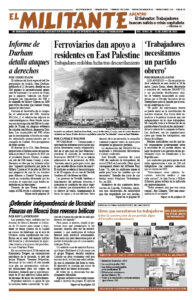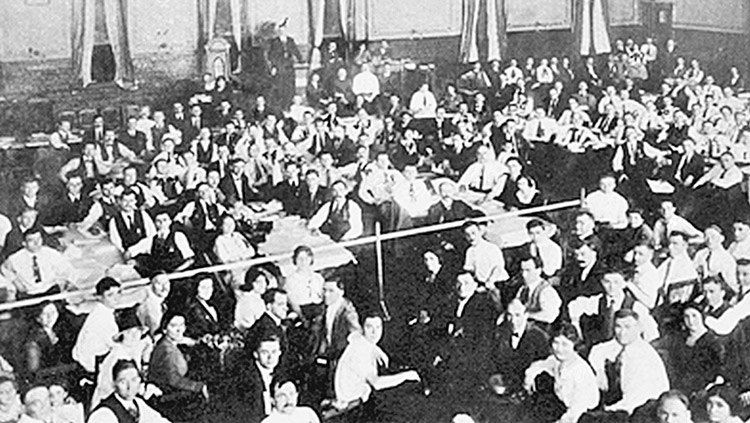The First Ten Years of American Communism: Report of a Participant by James P. Cannon is one of Pathfinder’s Books of the Month for June. Cannon describes his experiences as a founding leader of the Communist Party in the United States in 1919, charting a course to emulate the example of the Russian Revolution. But, as revolutions from Europe to China went down to defeat, the isolated Soviet government and the parties of the Communist International were transformed as Joseph Stalin led a bureaucratic counterrevolution. Expelled from the CP in 1928 for supporting Leon Trotsky’s fight to continue Lenin’s proletarian internationalism, Cannon led the communist current that became the Socialist Workers Party. The excerpt is from “Part 1: Letters to a Historian. My Thesis,” written March 2, 1954. Copyright © 1973 by Pathfinder Press. Reprinted by permission.
The Communist Party originally was a revolutionary organization. All the original leaders of the early Communist Party, who later split into three permanent factions within the party, began as American revolutionists with a perspective of revolution in this country. Otherwise, they wouldn’t have been in the movement in the first place and wouldn’t have split with the reformist socialists to organize the Communist Party.
Even if it is maintained that some of these leaders were careerists — a contention their later evolution tends to support — it still remains to be explained why they sought careers in the communist movement and not in the business or professional worlds, or in bourgeois politics, or in the trade-union officialdom. Opportunities in these fields were open to at least some of them, and were deliberately cast aside at the time.
In my opinion, the course of the leaders of American communism in its pioneer days, a course which entailed deprivations, hazards and penalties, can be explained only by the assumption that they were revolutionists to begin with; and that even the careerists among them believed in the future of the workers’ revolution in America and wished to ally themselves with this future.
It is needless to add that the rank and file of the party, who had no personal interests to serve, were animated by revolutionary convictions. By that I mean, they were believers in the perspective of revolution in this country, for I do not know any other kind of revolutionists.
The American Communist Party did not begin with Stalinism. The Stalinization of the party was rather the end result of a process of degeneration which began during the long boom of the Twenties. The protracted prosperity of that period, which came to be taken for permanence by the great mass of American people of all classes, did not fail to affect the Communist Party itself. It softened up the leading cadres of that party, and undermined their original confidence in the perspectives of a revolution in this country. This prepared them, eventually, for an easy acceptance of the Stalinist theory of “socialism in one country.”
For those who accepted this theory, Russia, as the “one country” of the victorious revolution, became a substitute for the American revolution. Thereafter, the Communist Party in this country adopted as its primary task the “defense of the Soviet Union” by pressure methods of one kind or another on American foreign policy, without any perspective of a revolution of their own. All the subsequent twists and turns of Communist policy in the United States, which appears so irrational to others, had this central motivation — the subordination of the struggle for a revolution in the United States to the “defense” of a revolution in another country.
That explains the frenzied radicalism of the party in the first years of the economic crisis of the Thirties, when American foreign policy was hostile to the Soviet diplomacy; the reconciliation with Roosevelt after he recognized the Soviet Union and oriented toward a diplomatic rapprochement with the Kremlin; the split with Roosevelt during the Stalin-Hitler pact; and the later fervent reconciliation and the unrestrained jingoism of the American Stalinists when Washington allied itself with the Kremlin in the war.
The present policy of the Communist Party, its subordination of the class struggle to a pacifistic “peace” campaign, and its decision to ally itself at all costs with the Democratic Party, has the same consistent motivation as all the previous turns of policy.
The degeneration of the Communist Party began when it abandoned the perspective of revolution in this country, and converted itself into a pressure group and cheering squad for the Stalinist bureaucracy in Russia — which it mistakenly took to be the custodian of a revolution “in another country.”
I shouldn’t neglect to add the final point of my thesis: The degeneration of the Communist Party is not to be explained by the summary conclusion that the leaders were a pack of scoundrels to begin with; although a considerable percentage of them — those who became Stalinists as well as those who became renegades — turned out eventually to be scoundrels of championship caliber; but by the circumstance that they fell victim to a false theory and a false perspective.
What happened to the Communist Party would happen without fail to any other party, including our own, if it should abandon its struggle for a social revolution in this country, as the realistic perspective of our epoch, and degrade itself to the role of sympathizer of revolutions in other countries.
I firmly believe that American revolutionists should indeed sympathize with revolutions in other lands, and try to help them in every way they can. But the best way to do that is to build a party with a confident perspective of a revolution in this country.
Without that perspective, a Communist or Socialist party belies its name. It ceases to be a help and becomes a hindrance to the revolutionary workers’ cause in its own country. And its sympathy for other revolutions isn’t worth much either.
That, in my opinion, is the true and correct explanation of the Rise and Fall of the American Communist Party.


